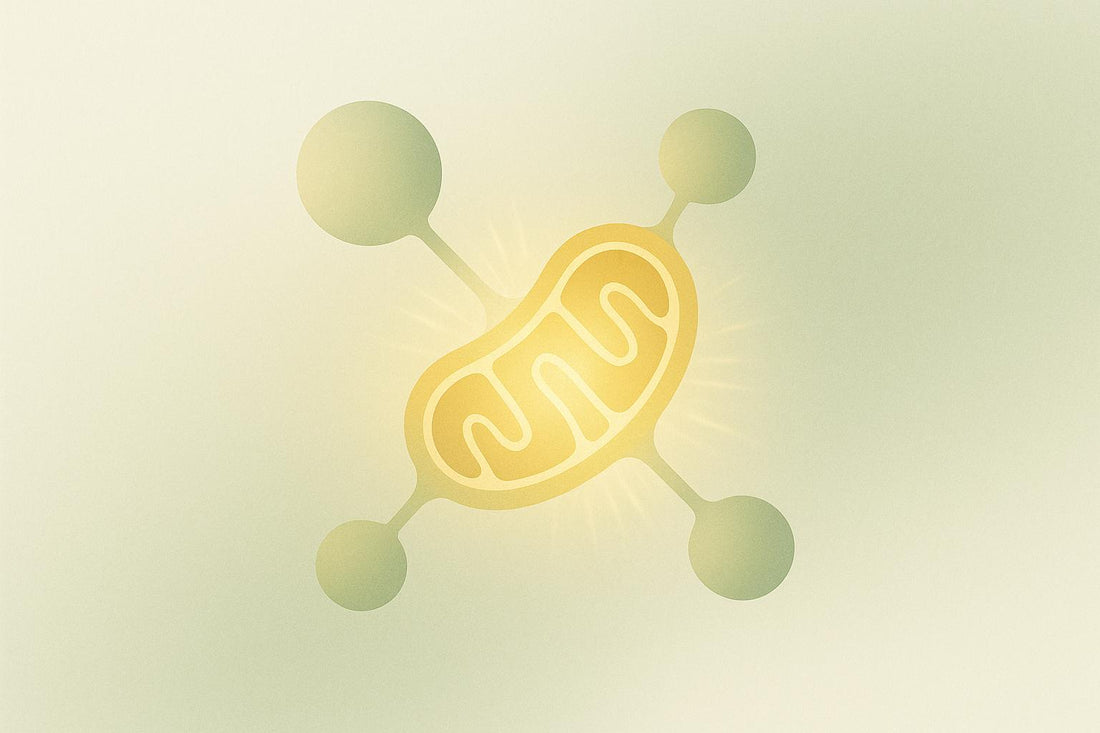Mitochondria power your cells, but oxidative stress can damage them, accelerating aging and increasing disease risks. Here's what you need to know:
- What happens: Mitochondria produce energy (ATP) but also generate reactive oxygen species (ROS) as byproducts. When ROS levels exceed the body's antioxidants, oxidative stress occurs, harming mitochondrial DNA, proteins, and lipids.
- Why it matters: Damaged mitochondria worsen energy production and contribute to chronic illnesses like Alzheimer’s, Parkinson’s, heart disease, and diabetes.
-
Prevention tips:
- Diet: Eat antioxidant-rich foods (berries, leafy greens, nuts).
- Exercise: Combine aerobic and resistance training.
- Sleep: Get 7–8 hours nightly for cellular repair.
- Supplements: CoQ10, Alpha-lipoic acid, L-carnitine, and B vitamins can protect mitochondria.
- Avoid toxins: Limit exposure to heavy metals and chemicals.
Supporting your mitochondria now can help maintain energy, slow aging, and reduce disease risks.
ROS Formation in Mitochondria and Defensive Mechanism
Causes and Effects of Mitochondrial Oxidative Stress
Grasping the origins and impacts of oxidative stress is essential when it comes to safeguarding your mitochondria. These tiny power plants of your cells face constant threats from reactive oxygen species (ROS), which can lead to far-reaching consequences, extending well beyond energy production issues. Let’s dive into where ROS come from and how they disrupt cellular function.
Where Reactive Oxygen Species (ROS) Come From
Mitochondria are both the main producers and victims of ROS. In fact, they generate about 90% of all ROS in your cells [4]. During normal energy production, a small fraction of the oxygen consumed is converted into superoxide anions, the most common form of ROS in mitochondria [4].
The electron transport chain (ETC) is the primary site for ROS production in mitochondria [4]. Within the ETC, Complex I and Complex III are the main contributors, while Complex II plays a smaller role [4]. Other mitochondrial components, such as mitochondrial glycerol-3-phosphate dehydrogenase (mGPDH) and electron-transferring flavoprotein–ubiquinone oxidoreductase (ETF-QOR), also generate ROS [4].
Outside of mitochondria, NADPH oxidases (NOX) are another significant source of ROS in cells [4].
How Oxidative Damage Affects Cell Function
Excessive ROS wreak havoc on mitochondrial DNA (mtDNA), proteins, and lipids. This damage reduces ATP production and can even trigger apoptosis, the programmed death of cells. Mitochondrial DNA is particularly vulnerable due to its proximity to ROS production sites and its lack of robust protective mechanisms.
Proteins and lipids critical to mitochondrial function, especially those involved in the respiratory chain, are also frequent targets of ROS. When these components are damaged, energy production drops drastically. This creates a harmful feedback loop: damaged mitochondria generate more ROS while producing less ATP, further depleting cellular energy.
As mitochondrial performance declines, cells may activate apoptosis pathways, leading to their death when damage becomes too extensive [1]. This cell loss accelerates tissue aging and organ dysfunction, laying the groundwork for chronic illnesses.
Connection Between Mitochondrial Damage and Chronic Disease
The relationship between mitochondrial oxidative stress and chronic diseases is undeniable. Mitochondrial dysfunction speeds up aging [1] and plays a role in many age-related health conditions.
"Mitochondrial oxidative stress, commonly associated with age-related pathologies (neurodegenerative syndromes, cardiovascular diseases, endocrine pathologies, diabetes, and cancer), can damage mitochondrial DNA, proteins, and lipids. The increased ROS presence can also induce chronic inflammation, which often characterizes age-related diseases and autoimmune pathologies."
- Yi-Ling Tsang et al. [5]
Take cardiovascular disease as an example. Research shows that hearts affected by disease often have 20% to 30% less ATP compared to healthy hearts [3]. Studies like the Framingham Heart Study and Baltimore Longitudinal Study on Aging link aging with increased left ventricular hypertrophy and declining heart function [3]. In experiments, mice exposed to Angiotensin II for four weeks developed high blood pressure, heart enlargement, cardiac fibrosis, and impaired heart function [3].
Neurodegenerative diseases such as Alzheimer's, Parkinson's, and Huntington's are also closely tied to mitochondrial dysfunction and oxidative stress [1]. The brain's high energy demands make it especially vulnerable to mitochondrial issues.
Beyond the brain and heart, mitochondrial damage is linked to metabolic disorders, cancer, liver diseases, and autoimmune conditions [2]. Specific disruptions in calcium regulation within mitochondria further heighten the risk of heart failure and atrial fibrillation [2]. With projections estimating that one in four people in developed regions will be 65 or older by 2050 [6], addressing mitochondrial oxidative stress is becoming increasingly vital for maintaining health and longevity.
"Mitochondria are closely associated with oxidative stress as mitochondria act as the sites of ROS generation and clearance. Accordingly, oxidative stress is the key threat to mitochondrial damage."
- Yi-Ling Tsang et al. [5]
This intricate link between oxidative stress and disease progression underscores the importance of protecting your mitochondria - not just for energy production, but for preserving your overall health and well-being.
Methods to Prevent Mitochondrial Oxidative Damage
Now that you know how oxidative stress can harm your mitochondria and contribute to chronic illnesses, let’s dive into practical strategies to shield these cellular powerhouses. By making specific lifestyle changes and using the right supplements, you can take control of your mitochondrial health.
Lifestyle Changes That Reduce Oxidative Stress
Your daily choices play a huge role in protecting your mitochondria. Environmental factors are considered one of the biggest influences in preventing disease [8], which highlights just how powerful your habits can be.
Start with your diet. Eating nutrient-dense foods is key to safeguarding mitochondria. Focus on antioxidant-rich options like berries, leafy greens, nuts, and seeds to help neutralize free radicals. Certain nutrients are particularly beneficial for mitochondrial health:
- B vitamins (from leafy greens and nuts) support energy production.
- CoQ10 (found in organ meats and fatty fish) protects the electron transport chain.
- Magnesium (from nuts and whole grains) aids essential cellular processes [9].
The Mediterranean diet is an excellent choice for mitochondrial support. Known for its emphasis on antioxidant-packed foods and healthy fats, it has been linked to a noticeable reduction in all-cause mortality [8].
Intermittent fasting (12–16 hours) can also work wonders for your mitochondria. It improves insulin sensitivity, promotes mitochondrial biogenesis (the creation of new mitochondria), and supports autophagy, a process where your body clears out damaged cells. Even a simple overnight fast can deliver benefits.
Exercise is another powerful tool. Regular aerobic activity increases the number of mitochondria in your cells, while resistance training boosts their efficiency. Together, these forms of exercise enhance energy production [7][9].
Don’t underestimate the importance of quality sleep. Aim for 7–8 hours each night to give your cells the time they need for maintenance and repair. Poor sleep can increase oxidative stress and slow mitochondrial recovery [9].
Finally, reducing your exposure to environmental toxins is essential. Simple steps like filtering your water, avoiding plastic food containers, choosing organic produce when possible, and using natural cleaning products can limit oxidative stress. Minimizing contact with heavy metals like lead, mercury, and cadmium is especially important for mitochondrial health [11].
Once you’ve established these habits, you can amplify their effects with targeted supplements.
How Supplements Protect Mitochondria
Lifestyle changes create a strong foundation, but supplements can provide an extra layer of protection for your mitochondria. Several options have been shown to enhance mitochondrial function and combat oxidative stress.
- Coenzyme Q10 (CoQ10): One of the most studied supplements for mitochondrial health, CoQ10 neutralizes free radicals and reactive oxygen species. Studies in mice show it can reverse mitochondrial oxidative stress, restore structure, and improve oxygen use. It’s especially helpful for people on statins, which can lower natural CoQ10 levels [10].
- Alpha-lipoic acid (ALA): This compound supports ATP production while reducing reactive oxygen species, making it beneficial for both energy and protection [9].
- L-carnitine: Essential for transporting fatty acids into mitochondria for energy, L-carnitine becomes increasingly useful as this process slows with age.
- NADH: A critical player in electron transport for ATP synthesis, NADH combined with CoQ10 can boost energy levels, particularly for those dealing with chronic fatigue [9].
- N-acetylcysteine (NAC): By supporting glutathione production - your body’s master antioxidant - NAC directly reduces oxidative stress and protects mitochondria [9].
- B vitamins: These vitamins act as cofactors in mitochondrial metabolic pathways, helping your body convert food into energy and maintain cellular health [9].
| Supplement | Primary Benefit for Mitochondria |
|---|---|
| CoQ10 | Neutralizes free radicals; supports electron transport |
| Alpha-lipoic acid | Reduces ROS buildup; supports ATP production |
| L-carnitine | Transports fatty acids for energy production |
| NADH | Facilitates electron transport for ATP synthesis |
| NAC | Boosts glutathione production; reduces oxidative stress |
Using Lifestyle and Supplements Together
Combining healthy habits with targeted supplements can maximize your mitochondrial resilience. Start with a strong foundation: a diet rich in antioxidants, regular aerobic and resistance exercise, and consistent, high-quality sleep. These steps can significantly lower oxidative stress and improve mitochondrial function.
From there, add supplements based on your specific needs. For example, if you’re on statins, CoQ10 is a must. If fatigue is a concern, pairing NADH with CoQ10 may help restore your energy. A combination of CoQ10, alpha-lipoic acid, and NAC can provide well-rounded support for most people.
Timing matters, too. Taking supplements with meals can improve absorption, while syncing exercise and fasting periods can further stimulate mitochondrial biogenesis.
"Mitochondrial dysfunction can be either the cause or the result of chronic health issues, each of which requires different treatment approaches."
sbb-itb-4f17e23
MASI Longevity Science: Advanced Solutions for Mitochondrial Health

MASI goes beyond basic lifestyle adjustments and supplements with advanced solutions designed to support cellular health. By leveraging recent discoveries in combating cellular aging, MASI Longevity Science has developed supplements that address four primary factors contributing to aging. Below, we’ll explore the science behind their formulas, their uncompromising quality standards, and why they’ve become a trusted name in mitochondrial health.
Science-Based Formulas for Longevity
MASI’s supplements are built around four powerful compounds: NMN, Resveratrol, Fisetin, and Spermidine. Each one targets specific cellular pathways to combat aging and improve mitochondrial function.
- NMN (Nicotinamide Mononucleotide): This compound restores NAD⁺ levels, which are essential for mitochondrial energy production and DNA repair. As we age, NAD⁺ levels decline, leading to slower energy production and less efficient DNA repair, both of which accelerate aging [14].
- Resveratrol: A plant-based polyphenol, Resveratrol enhances mitochondrial biogenesis, reduces oxidative stress, and supports mitochondrial oxygen regulation. It also activates sirtuins, proteins that protect DNA and improve mitochondrial health. According to experts, “Mitochondrial dysfunction and oxidative stress are thought to play important roles in mammalian aging” [13].
Together, NMN and Resveratrol form a dynamic duo: NMN energizes mitochondria, while Resveratrol strengthens their defense mechanisms.
- Spermidine: This compound promotes autophagy, a natural process that clears out damaged cellular components, including mitochondria. Autophagy rejuvenates cells, and studies show that Spermidine can extend the median lifespan of organisms like mice and worms while offering cardiovascular benefits [12].
- Fisetin: Fisetin focuses on eliminating senescent cells - damaged cells that contribute to inflammation and aging. By clearing these cells, Fisetin reduces inflammation and eases the burden on healthy mitochondria.
MASI’s Longevity+ formula combines NMN, Cycloastragenol, CoQ10, Resveratrol, and Selenium to tackle aging from multiple angles. This multi-ingredient approach provides more comprehensive support than single-compound supplements [14].
Quality and Purity Standards
MASI prioritizes pharmaceutical-grade quality, crafting its products in Germany using premium raw materials. Every batch adheres to strict European manufacturing standards, ensuring consistency and potency.
To guarantee safety and effectiveness, MASI conducts independent testing in Switzerland. This third-party verification ensures that the ingredients listed on the label match what’s inside the bottle, free from contaminants.
MASI’s products are also designed to meet diverse dietary needs. They are vegan-friendly and free from GMOs, soy, lactose, gluten, and common allergens, allowing users to focus on improving mitochondrial health without worry.
The company’s boutique production model ensures exceptional quality control. MASI is the only manufacturer in Germany producing NMN, Spermidine, Fisetin, and Resveratrol supplements using locally sourced raw materials, maintaining strict oversight at every production stage.
Trusted by a Global Longevity Community
With over 352,000 longevity enthusiasts relying on their products, MASI has built a reputation for delivering reliable, research-driven solutions.
MASI’s commitment to science is evident in their collaborations with prestigious institutions like Harvard and the Mayo Clinic. Their formulations are grounded in rigorous research, ensuring that every ingredient is backed by credible studies.
To make consistent supplementation accessible, MASI offers a flexible subscription model. Monthly subscriptions include a 5% discount, while annual plans provide 15% savings. This approach supports the long-term commitment needed to protect mitochondrial health.
MASI emphasizes that maintaining mitochondrial health isn’t about quick fixes - it’s about sustained care. By combining premium formulas with a supportive community, MASI provides the tools needed for a science-based approach to longevity.
Protecting Mitochondria for Better Health and Longevity
Mitochondria are the powerhouse of your cells, working tirelessly to fuel nearly all essential functions in your body. For instance, your brain alone uses about 70% of the ATP these energy factories produce [15]. This constant activity highlights how even minor disruptions in mitochondrial function can have a ripple effect on your overall health.
In the U.S., mitochondrial diseases affect about 1 in every 4,300 individuals. Even more concerning, every half hour, a child is born who will develop a mitochondrial disorder by the age of 10 [17]. These numbers emphasize the importance of safeguarding mitochondrial health.
Key Insights About Mitochondria
To better understand the role of mitochondria in health and longevity, here are some important points:
- Mitochondria and Lifespan: The amount of reactive oxygen species that mitochondria leak is closely tied to longevity [15].
- The Importance of Early Action: Healthy mitochondria are fundamental to overall well-being, while dysfunction is linked to numerous chronic diseases. Addressing mitochondrial health early can lead to noticeable improvements in energy and vitality [9].
- A Comprehensive Strategy: Protecting mitochondria involves a mix of lifestyle changes and targeted nutritional support. This includes optimizing your diet, minimizing exposure to toxins, maintaining muscle mass, and supporting ATP production [15].
- A Growing Field of Research: Over the last 30 years, mitochondria have become a focus for therapeutic advancements in treating common diseases. The body of research on mitochondria continues to grow rapidly [16][18].
These facts underline the critical need to prioritize mitochondrial health.
Steps to Support Longevity
If you're looking to protect your mitochondria and support long-term health, here’s where to start:
- Stick to the Basics: A balanced diet, regular physical activity, and stress management are foundational for maintaining mitochondrial health [9].
- Explore Targeted Supplements: MASI Longevity Science offers formulations with NMN, Resveratrol, Fisetin, and Spermidine, specifically designed to support mitochondrial function and address key aging factors. These supplements are crafted in Germany with pharmaceutical-grade materials and undergo independent testing in Switzerland to ensure purity and safety.
- Commit to Consistency: Protecting mitochondria requires ongoing effort. MASI provides flexible subscription options, offering 5% savings on monthly plans and 15% on annual plans, making it easier to stay consistent.
- Join a Supportive Community: With a global network of over 352,000 members, MASI’s longevity community shares science-backed insights and guidance to help you maintain mitochondrial health for years to come.
"Mitochondria are central to your health and longevity." - Nutrition Diets [9]
The path forward is clear: take action now to protect these vital cellular engines. Investing in your mitochondrial health today can lead to a healthier, more energetic tomorrow.
FAQs
What are reactive oxygen species (ROS), and how can we protect mitochondria from their harmful effects?
Reactive oxygen species (ROS) are unstable molecules that can harm mitochondrial DNA, proteins, and lipids. This damage can disrupt mitochondrial function and accelerate cellular aging - a process referred to as oxidative stress, which is closely tied to age-related decline.
Here are a few ways to protect mitochondria from ROS:
- Lower ROS production: Reducing mitochondrial membrane potential can help decrease stress and limit ROS formation.
- Use specialized antioxidants: Compounds like mito-TEMPO or MitoQ10 are designed to directly neutralize ROS within mitochondria.
- Maintain mitochondrial quality control: Supporting a healthy balance of fission and fusion processes helps clear out damaged mitochondria and keeps the system functioning efficiently.
Taking these steps can help preserve mitochondrial health, which plays a vital role in supporting cellular longevity.
What lifestyle changes and supplements can help protect mitochondria from oxidative stress and support healthy aging?
To keep your mitochondria protected from oxidative stress and support healthy aging, it's essential to focus on a few key lifestyle habits. Start with a balanced diet filled with whole, unprocessed foods, incorporate regular physical activity into your routine, and consider practicing moderate caloric restriction. These steps can help minimize oxidative damage and maintain cellular health.
Beyond lifestyle changes, certain supplements can provide additional support for mitochondrial function. Options like N-acetylcysteine, vitamin E, and mitochondrial-specific antioxidants are often used to combat oxidative stress and boost cellular energy. For a more focused approach, supplements containing compounds such as NMN, Resveratrol, Fisetin, and Spermidine are designed to target aging at its core, while also supporting energy levels, brain function, and cellular repair.
By blending these lifestyle adjustments with targeted supplementation, you can take proactive steps to protect your mitochondria and promote overall health and vitality.
What is mitochondrial dysfunction, how does it contribute to chronic diseases, and what early warning signs should you watch for?
Mitochondrial dysfunction happens when the mitochondria - those tiny powerhouses in your cells - don’t function as they should. Since mitochondria are responsible for producing the energy your body needs, their failure can lead to reduced energy at the cellular level. This is often tied to chronic health issues, including neurological disorders, muscle weakness, and metabolic diseases. Over time, these problems can take a serious toll on your overall well-being.
Common early signs to be aware of include:
- Persistent muscle weakness or fatigue
- Struggling with physical activity or exercise intolerance
- Neurological symptoms, such as seizures or developmental delays
- Issues with growth, vision, or hearing
- Signs of organ dysfunction, like problems with the heart or liver
Spotting these symptoms early and seeking medical advice can be key to managing mitochondrial health. Steps like making lifestyle adjustments or using targeted supplements might help improve cellular energy production, potentially supporting long-term health and vitality.




